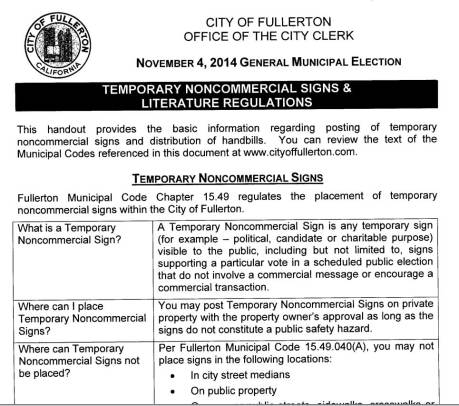
Signs are not permitted on fences surrounding flood control channels, but many are posted there anyway.
Item Number 10 on the Fullerton City Council’s agenda for April 1, 2014 is a review of the city’s ordinance governing the placement of temporary noncommercial signs on public property. “Temporary noncommercial” generally refers to signs placed by non-profit institutions or political campaigns. Such signs are not technically allowed on public property, according to Fullerton Municipal Code (FMC) Section 15.49. Nonprofit organizations advertise fundraisers, soccer league signups, and any number of public-spirited events and activities on city owned fences, and most people don’t mind, as long as they aren’t sectarian and they don’t stay up too long. Election season brings political signs, however, and the City must take care that it doesn’t tacitly endorse one candidate over another by allowing signs from one campaign to remain on property owned by the public while removing those from opposing campaigns.
In the past, Fullerton has demonstrated some degree of laxity over the placement of signs on fences and near curbs, but the contentious 2012 Recall/Council elections brought a noticeable increase in the removal of signs by city employees. Signs placed late at night were gone by the early morning of the next day. (The City will keep the signs at its maintenance yard for pickup by the campaign for thirty days rather than throwing them away immediately).
City property is distinguished from other facilities like utility poles, owned by electricity providers, and flood control property, managed by the county. While most candidates know enough to avoid posting signs on telephone poles, signs frequently appear on fences bordering flood control channels or swinging on horizontal poles connected to utility poles. The city’s code notes that employees of those agencies “may remove signs posted on their property,” implying that city employees will limit their sign removal to city property. However, during the last election cycle, at least one candidate reported that city employees acknowledged removing signs from flood control fences. Overnight removals of signs placed on flood control fences during a time when county employees were only sent out on a bi-weekly basis at best lent credence to this report. (These signs were later found at the city yard).

During the 2012 campaign season candidate signs were regularly removed from this fence, while nonprofit signs were allowed to stay.
It should be noted that the City allows banners to be hung for years as part of a program “honoring” local residents or institutions. These banners are on public property, and carry the names of sponsoring businesses and organizations–often nonprofits, but often businesses. Some of these banners feature images of the businesses themselves, begging the question of just who is being “honored” and how it is any different from an outright advertisement.

Hanging in the public right-of-way. Who is this banner “honoring,” and what is it advertising? Should nonprofits and political signs take a back seat to commercial signs on public property?
Although it might seem that the City’s efforts to keep inappropriate signs from invading space owned by the public is laudable, one could also argue that there is a value in tolerating signs where they normally wouldn’t be allowed for a reasonable amount of time during campaign season. Councilmember Bruce Whitaker has made the point in the past that signs can be the single most important method of communication for less well-funded campaigns on behalf of candidates who cannot afford multiple mailings or newspaper advertisements.
The City is also wrong to distinguish between political campaign signs and those posted by nonprofit organizations because the law does not distinguish between the two. Both are equally protected forms of free speech, although they do have different financial reporting requirements. Instead of trying to remove political signs from the public sphere, Fullerton could establish a reasonable period of time, perhaps between Labor Day and Election Day in the Fall, for example, to leave campaign signs where they normally wouldn’t be allowed in the interest of communication between voters and candidates.


